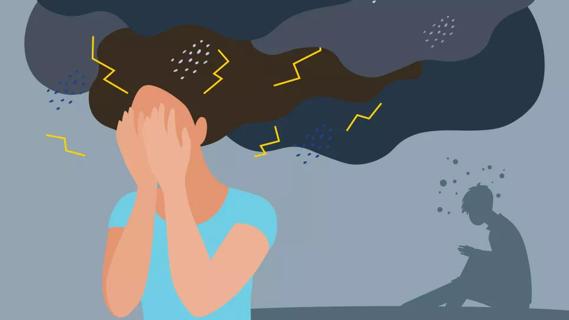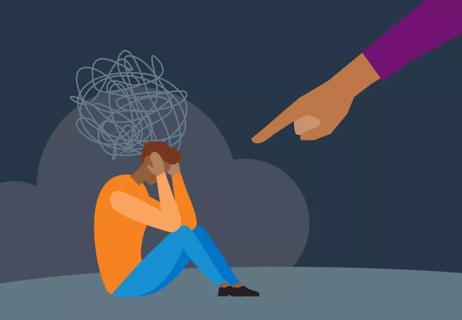Past negative experiences can affect you throughout your life

What do you think of when you think of trauma?
Advertisement
Cleveland Clinic is a non-profit academic medical center. Advertising on our site helps support our mission. We do not endorse non-Cleveland Clinic products or services. Policy
It can happen as a result of abuse, violence or neglect. But it can also be due to a loss, war or a natural disaster.
Trauma can happen to anyone, anytime, and the mental, physical, social and emotional effects of it can last a lifetime.
And that can mean doctor’s appointments and exams can feel invasive and trigger certain feelings and emotions. Doctors may unknowingly make situations worse when the goal is to provide care in a safe environment.
That’s why an approach to healthcare, known as trauma-informed care, is so important. It considers the experiences of each individual, how trauma may impact their lives, what symptoms they’re experiencing and then works to prevent re-traumatization.
“The goal of trauma-informed care is shifting the lens of how we care for people,” says trauma expert Michele Reali-Sorrell, DNP, RN, SANE-A, SANE-P. “Instead of saying, ‘What’s wrong with you?’ we change that into ‘What happened to you?’”
She explains the principles of trauma-informed care, how it works and why it matters.
The Substance Abuse and Mental Health Services Administration (SAMHSA) defines trauma as “a result from an event, series of events or set of circumstances that is experienced by an individual as physically or emotionally harmful or life-threatening and that has lasting adverse effects on the individual’s functioning and mental, physical, social, emotional or spiritual well-being.”
Advertisement
“When people think of trauma, they typically think of physical injury. A person has a life-threatening car accident or gunshot wound — something very traumatic happened to their physical body,” says Reali-Sorrell. “So yes, that’s part of it. But trauma is also emotional trauma, mental trauma and spiritual trauma.”
Some symptoms of trauma may include:
Here are some examples of the principles healthcare providers may use in their trauma-informed approach to care.
The first principle is safety. The goal is to make sure that individuals feel physically and psychologically safe at their appointment.
So, what does that look like?
“It’s making sure that when a doctor’s office schedules an appointment, the individual knows what to anticipate at that appointment,” says Reali-Sorrell. “We want to give them as much information as we can so there are no surprises.”
In some specialty clinics, victim advocates can help individuals apply for a restraining order and apply for victims of crime compensation, a program offered in all states.
“Our goal is to build trust. The individual is the driver on each decision. Do they want to talk to law enforcement? Do they want to press charges? Do they want to start on certain medications?” says Reali-Sorrell. “So, it’s involving them and building that trust.”
And it even goes back to small details like a doctor asking for permission before touching a person or even offering them a choice on where they’d like to sit during an appointment.
Through peer support — whether that’s support groups or shared appointments — the goal is to connect to others who have gone through or are going through the same traumatic experience.
“What we do is connect people with resources in the community where they can get that peer support,” says Reali-Sorrell. “We work with mental health services, counseling and survivor groups.”
Across the board, it’s important to all be on the same page. From the medical staff to any outside providers, it’s key that no one has more power or say than the other.
That sense of collaboration and mutuality helps when it comes to ensuring each person gets the care they need and tries to limit the number of appointments they need to schedule. An appointment may include bloodwork while also meeting with a social worker to maximize time and accessibility.
Advertisement
And it includes helping each person throughout their journey, whether that’s providing information on mental health services or helping schedule an upcoming appointment.
“We know that sometimes when people need to schedule follow-up appointments, they might not be able to get right away or they don’t have the courage or energy to make that call,” notes Reali-Sorrell. “So, we try to do as much of that upfront for them as possible.”
While making sure everyone is on a level playing field, it’s also vital that those receiving care feel empowered.
Many times, someone seeking care may feel that their doctor has power over them.
“We empower people. We validate what they’ve been through. We believe them,” explains Reali-Sorrell. “It’s empowering them to be the person that steers their health and wellness. And what can we do to help empower you, what resources do you need.”
It’s essential that each person providing care recognizes any biases and stereotypes.
“We need to acknowledge our own personal biases and our own stereotypes, as well as what biases or stereotypes each person we care for might have,” says Reali-Sorrell. “Working on how we implement our own experiences in life and how that affects the way we do care and how we treat people is key.”
Advertisement
For those receiving treatment through trauma-informed care, the benefits can include:
Research shows that trauma can impact long-term negative health outcomes, including effects on brain development and cognition.
The study also looks at adverse childhood experiences, which include factors like violence, abuse, neglect, having a family member with a mental health condition or instability in the home. It shows a connection between trauma and an increased risk of disease and disability.
“The more you’re exposed to as a child when you’re in those very crucial years of developing your self-worth and self-esteem, communication can be disrupted by trauma,” states Reali-Sorrell. “That can affect how you cope and how you deal with your physical and mental health.”
By following the principles of trauma-informed care, providers will have a complete picture of the person’s life and any trauma that has occurred.
They may have developed negative coping skills, as well as poor health or hygiene habits.
In addition to making sure each person isn’t re-traumatized as they go through their treatment, understanding what’s happened to each person allows providers to provide treatment and services that will lead to a better health outcome.
Advertisement
The goal is to come up with a treatment plan that works for each individual to ensure they have a better quality of life.
And if you aren’t sure that your doctor or provider is offering trauma-informed care, start by having a conversation with them.
“It’s OK to say to your doctor that you have some physical things you want to talk about,” reassures Reali-Sorrell. “But let them know that you also have some emotional or mental needs as well.”
A visit to a doctor should be a safe space and isn’t just for treating physical illness — it’s about treating your entire mind, body and soul.
Overall, trauma-informed care aims to treat everyone with empathy and help them heal from their experience.
“We’ve all gone through some kind of trauma in our lives,” says Reali-Sorrell. “By using trauma-informed care, each person can be engaged and invested in their own health and thrive in their surroundings.”
Learn more about our editorial process.
Advertisement

Identify your emotional triggers, come to terms with your regrets and allow yourself to be a kid again

Your inner child is a representation of your childhood experiences and the ways they can still affect you on a day-to-day basis

This alternative brain-body therapy focuses on unlocking pent-up feelings, memories and tension that may be stuck in your brain and body

Absorbing others’ trauma can take a big toll on your own mental health

The glue that helps hold an abusive relationship together

A glass child is the sibling of someone with special needs — often seen as the easy one, but carrying invisible burdens

This evidence-based practice is used to help manage pain, relieve menopause symptoms and boost your spirits

Yes, new fathers can experience mood changes after bringing baby home

If you’re feeling short of breath, sleep can be tough — propping yourself up or sleeping on your side may help

If you fear the unknown or find yourself needing reassurance often, you may identify with this attachment style

If you’re looking to boost your gut health, it’s better to get fiber from whole foods